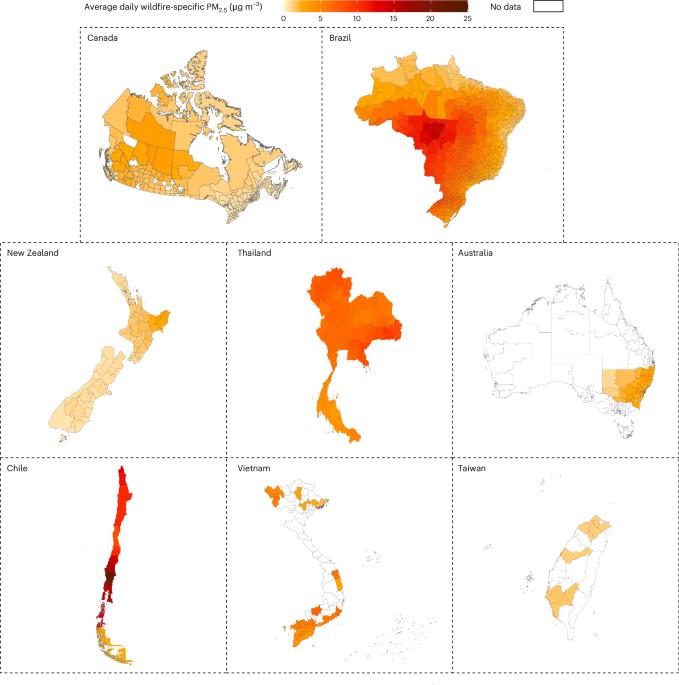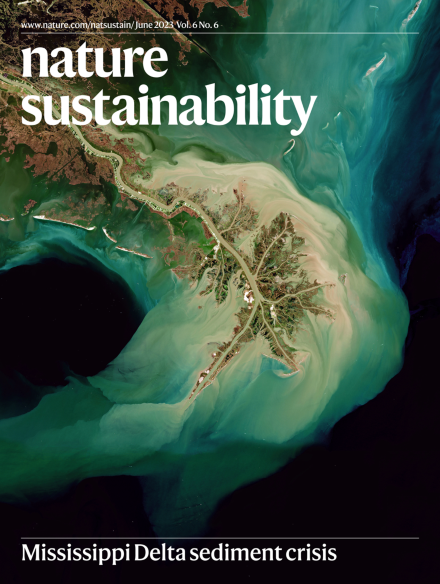Respiratory risks from wildfire-specific PM2.5 across multiple countries and territories
IF 27.1
1区 环境科学与生态学
Q1 ENVIRONMENTAL SCIENCES
引用次数: 0
Abstract
Under a warming climate, wildfires are becoming more frequent and severe. Multicountry studies evaluating associations between wildfire fine particulate matter (PM2.5) and respiratory hospitalizations are lacking. Here we evaluate the short-term effects of wildfire-specific PM2.5 on respiratory hospitalizations from 1,052 communities across Australia, Brazil, Canada, Chile, New Zealand, Vietnam, Thailand and Taiwan, during 2000–2019. A 1 µg m−3 increase in wildfire-specific PM2.5 was associated with increased hospitalization risks for all-cause respiratory, asthma, chronic obstructive pulmonary disease, acute upper respiratory infection, influenza and pneumonia by 0.36%, 0.48%, 0.38%, 0.42%, 0.79% and 0.36%, respectively. Higher risks were observed among populations ≤19 or ≥60 years old, from low-income or high non-wildfire PM2.5 communities, and residing in Brazil, Thailand, Taiwan and Vietnam. Australia and New Zealand exhibited a greater hospitalization risk for asthma associated with wildfire-specific PM2.5. Compared with non-wildfire PM2.5, wildfire-specific PM2.5 posed greater hospitalization risks for all respiratory diseases and a greater burden of asthma. Wildfire-specific PM2.5 contributed to 42.4% of PM2.5-linked respiratory hospitalizations, dominating in Thailand. Overall, the substantial contribution of wildfire-specific PM2.5 to respiratory hospitalizations demands continued mitigation and adaptation efforts across most countries. Intervention should be prioritized for influenza, children, adolescents, the elderly and populations in low-income or high-polluted communities. Wildfires are becoming increasingly frequent in several regions around the world due to climate change, posing serious health risks, especially for respiratory diseases. This study examines the respiratory health risk and burden of wildfire-specific PM2.5 pollution across eight countries and territories.

多个国家和地区野火特有PM2.5造成的呼吸风险
在气候变暖的情况下,野火变得更加频繁和严重。目前缺乏评估野火细颗粒物(PM2.5)与呼吸道住院之间关系的多国研究。在这里,我们评估了2000年至2019年期间,野火特异性PM2.5对澳大利亚、巴西、加拿大、智利、新西兰、越南、泰国和台湾1052个社区呼吸系统住院治疗的短期影响。野火特异性PM2.5每增加1µg−3,全因呼吸道、哮喘、慢性阻塞性肺疾病、急性上呼吸道感染、流感和肺炎住院风险分别增加0.36%、0.48%、0.38%、0.42%、0.79%和0.36%。年龄≤19岁或≥60岁,来自低收入或非野火PM2.5高社区,以及居住在巴西、泰国、台湾和越南的人群中,风险较高。澳大利亚和新西兰与野火特有的PM2.5相关的哮喘住院风险更高。与非野火PM2.5相比,野火特异性PM2.5对所有呼吸系统疾病的住院风险更高,哮喘负担更大。野火特有的PM2.5造成了42.4%与PM2.5相关的呼吸道住院,在泰国占主导地位。总体而言,野火特有的PM2.5对呼吸道住院的巨大贡献要求大多数国家继续采取缓解和适应措施。干预措施应优先针对流感、儿童、青少年、老年人和低收入或高污染社区的人口。由于气候变化,野火在世界各地的一些地区变得越来越频繁,造成严重的健康风险,特别是呼吸道疾病。本研究调查了八个国家和地区野火PM2.5污染的呼吸健康风险和负担。
本文章由计算机程序翻译,如有差异,请以英文原文为准。
求助全文
约1分钟内获得全文
求助全文
来源期刊

Nature Sustainability
Energy-Renewable Energy, Sustainability and the Environment
CiteScore
41.90
自引率
1.10%
发文量
159
期刊介绍:
Nature Sustainability aims to facilitate cross-disciplinary dialogues and bring together research fields that contribute to understanding how we organize our lives in a finite world and the impacts of our actions.
Nature Sustainability will not only publish fundamental research but also significant investigations into policies and solutions for ensuring human well-being now and in the future.Its ultimate goal is to address the greatest challenges of our time.
 求助内容:
求助内容: 应助结果提醒方式:
应助结果提醒方式:


